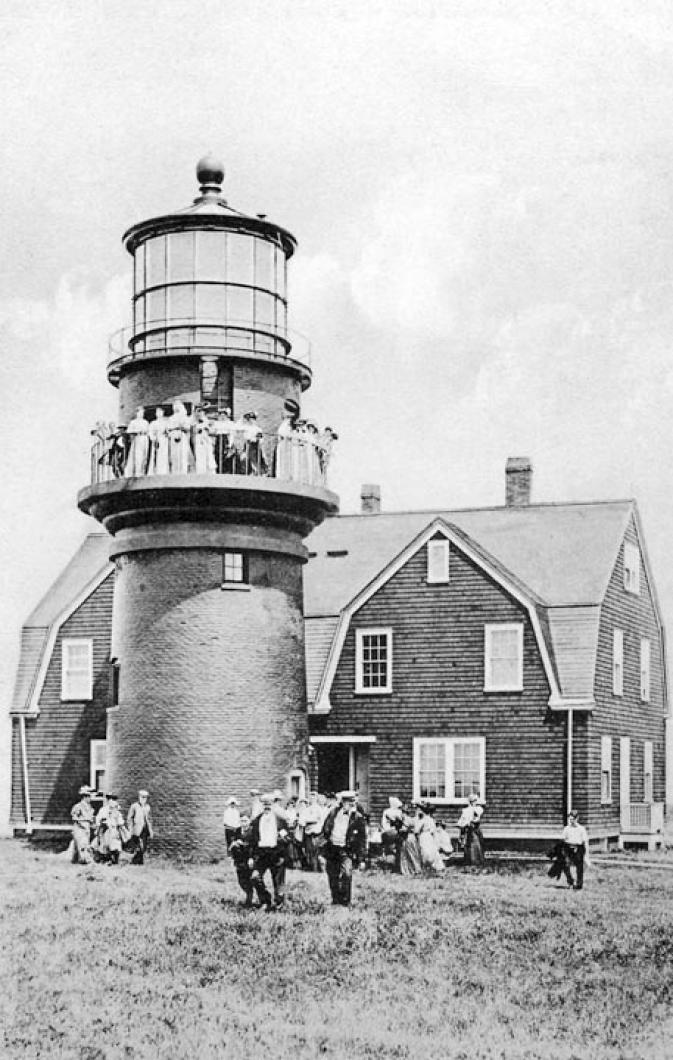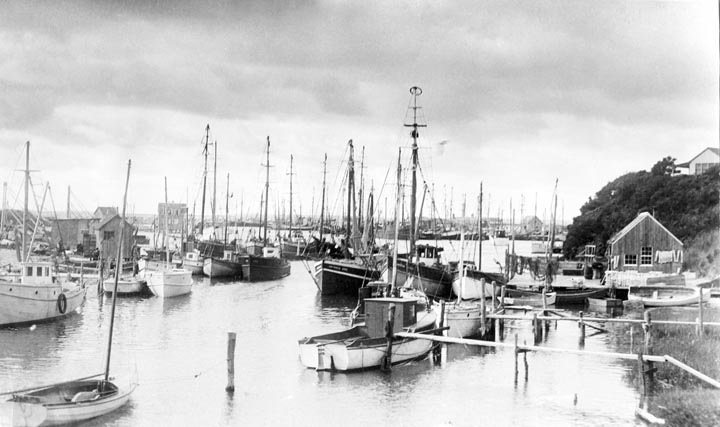As the response to a recent non-hurricane demonstrated, there is a longstanding tension on the Vineyard about whether it is one cohesive Island or rather a balkanized land mass of individual towns, each with their own personalities and interests. This Saturday the Martha’s Vineyard Museum celebrates that tension in kicking off a year-long exhibit titled Your Town, Our Island.
“It’s really interesting that an Island this small with such a shared sense of history can develop such distinct towns,” said assistant curator Anna Carringer on Wednesday as she and chief curator Bonnie Stacy put the final touches on an expansive exhibit that includes not only relics from Island life, like coins recovered from the great Vineyard Haven fire of 1883, but also oral history recordings and video presentations that tell both the stories of individual towns and of the Vineyard community as a whole.
“We all live here and identify ourselves with a certain town,” she said. “People have a sense of pride about it.”
One of the most difficult tasks for Ms. Carringer and Ms. Stacy was whittling down the museum’s vast collection in storage to only a few artifacts to represent each town, whether pottery from Aquinnah, or antique hand-painted paper lanterns from the Bradley Memorial Church in Oak Bluffs.
“Each of these things is just the tip of the iceberg in terms of what we had to draw from,” said Ms. Stacy.
People from West Tisbury may bristle at being represented by an iconic hermit, but there is no denying the compelling strangeness of Nancy Luce. From the seemingly serious headstones on display commemorating her beloved hens — “Poor Tweedle Dedel Bebbee Pinky Died June 19 1871,” reads one — to private screeds penned in a baroque script about the cruelty of man, all indications are that Ms. Luce was unwell. And yet she became something of a folk hero in West Tisbury, where relatives still adorn her gravestone with poultry figurines.
“She was eccentric to say the least,” said Ms. Carringer, who says that on at least one occasion Ms. Luce fired shots at a curious trespasser. “She was a poet, an artist and became something of an early-day tourist attraction.”
Part of that attraction included stereoscopic photographs of herself that she would sell to visitors, one of which the museum will display in all its 19th century 3-D grandeur.
Across the room and unavoidable is Heather Neill’s sweeping painting, Strider’s Surrender, an eight-foot-long ode to the collapse of the fishing industry in Menemsha. Depicting Jonathan Mayhew’s Quitsa Strider with a symbolic white rag affixed to its rigging, the painting serves as a lament: after generations of Mayhew fishermen, Jonathan was forced to sell his federal offshore groundfishing permits in 2007 and put the Strider up for sale.
“It’s a tribute to this boat but also a commentary on the state of fishing on the Island,” said Ms. Carringer.
Any exhibit of Chilmark would be incomplete without some exploration of its once-sizable deaf community, which had its own dialect and sign language and in Squibnocket represented up to a quarter of the population at one point. The museum will include a video of the late Eric Cottle demonstrating some of the signs used in Chilmark.
Everyone knows Edgartown for its whaling, a history that is well documented in other wings of the museum, but equally important to its economy over the centuries has been fishing. With that in mind the museum will display antique equipment, including nets used to scoop herring out of Mattakeesett Creek by the hundreds as well as a weather-beaten but surprisingly well-preserved door from a 19th century Chappaquiddick fishing shanty named Good Cheer! Still legible on the door as if they were written yesterday are the scrawlings of hardy fishermen who used the shack as a redoubt during some of the harshest winters known.
“March 22 1885. The harbor FROZEN OVER to Cape Poge,” one reads, “Vessels unable to get in or out. Man seen walking on the ice.”
“1886 hard storm,” reads another, “South beach broken open for first time in 80 years.”
Ms. Carringer isn’t sure how the museum came into possession of the door but says that one of the joys of an exhibit like this is that visitors may shed more light on an artifact’s provenance.
“Someone might come in and say ‘Good Cheer! That was my uncle’s fishing shack, let me tell you all about it,’ ” she said.
Thanks to a National Endowment for the Humanities grant, the museum will be conducting forums this winter to allow Islanders to tell their own stories of the towns they love. Eventually, as part of that grant, the museum hopes to establish a permanent exhibit on Island history; this exhibit is the first step.
“People can make their own decision whether the stories we chose are the right ones to represent their town,” said Ms. Stacy. “And if not, they can tell us their own.”
Although each town is unique, few things unite the Island like disaster, whether natural or, in one case, congressional. One room that illustrates the Island’s shared agricultural and marine industry also contains an artifact to Islanders’ one-time shared indignation. In 1977, after losing their congressional representative and consolidating with Cape Cod, a group of Vineyarders embarked on a (depending whom you ask) tongue-in-cheek effort to secede from Massachusetts and perhaps even the United States. A rare framed copy of the Martha’s Vineyard National Anthem in the exhibit captures the boisterous mood of those quixotic rebels:
“Twas the Big Freeze of Seventy Seven/A group got together numb’ring ‘bout eleven/The farmers, the fishermen, selectmen too/Islanders all, to decide what to do/A rallying cry was heard the Isle thru/‘It’s time to SECEDE from YOU KNOW WHO!’”
Also in the room is a pictorial display exploring the role of hurricanes and great storms as unifying features of Island life. The gale of 1898, the hurricanes of 1938 and 1944 and, of course, Bob are all represented. Hurricane Earl failed to make the cut.
The opening reception for Your Town, Our Island is on Saturday at the Martha’s Vineyard Museum on School street in Edgartown from 3 to 5 p.m.








Comments (1)
Comments
Comment policy »